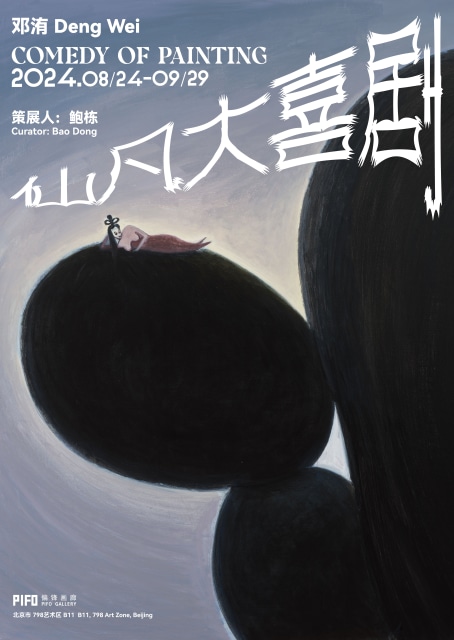The Comedy of Painting
By Bao Dong
Painting - to borrow Hegel's philosophical assertion of history - happened twice, the first as true drama, the second as comedy. In the former, painting blossomed to build its history, acquiring its discipline and ontology, whereas in the latter, the medium turns on itself, or more precisely, probes, ridicules, and satirizes its own ontology. Between what to paint and how to paint it, Hegel discovered early on that "What the work of art now inspires in us, apart from its immediate enjoyment, also demands our judgment; we simultaneously contemplate the work’s content and its means of expression, and whether the what and how is fitting or not."
In this sense, claiming Deng Wei's paintings as "comedy" is not only grounded on his subjects, stories, and iconography, despite their compelling comedic effect, ranging from the Tang Monk and his disciples lying on the beach on vacation, the Chinese conch maiden with mermaid's tail in the field of snails, and how generalized and evocative he depicts the urban police, sanitation workers and beggars. The actual intrigue in Deng's paintings is the way in which he deliberately creates the "tease" between the language and the content of his paintings, which affords intellectual relaxation and appreciation. Yes, comedy, in particular, should avoid the provision of an “immersive” experience, instead placing the spectator on the judicial stand to "laugh at" and "mock."
We discover various painterly elements in Deng's paintings, including Cubist geometry, child-like outlines, flat surfaces, unusual and contrasting colors, graffiti-style brushstrokes, text, warped spatial dispositions, and carefully controlled, dynamically balanced compositions. Language and style have become Deng’s pictorial content, the object that requires the spectator’s scrutiny; whereas the subjects, or more precisely, the characters, icons, scenes, and stories depicted with such language and style, are only the means by which Deng presents his "pictorial comedy". Hence, his subjects would none other than our most familiar cultural icons such as Journey to the West, the Seven Fairies, the folk stories and etc.
In a time when the painted medium has become superfluous, a work on canvas does nothing but appropriate what has been painted in the past. In fact, Deng's repetition of these specific subjects is both a kind of self-exegesis and an ever-expanding index, like Theseus’s Boat. With this classic deconstructionist metaphor, paintings reveal a hint of cunning manner from those serious expressions.
August, 2024
Translated from Chinese by Fiona He. (英文翻译:贺潇)
About the Artist
Deng Wei, born in 1978 in Shimen, Hunan Province, is of the Tujia ethnic group. As a graduate of the Guangzhou Academy of Fine Arts, Deng now serves as a teacher at the Hubei Institute of Fine Arts.
Deng Wei is an artist with "worldly humor". His works are full of "teasing" and "flirting" with acrimony. He broke away from the charming temperament and impressive skills of academicism, and challenged the mundane reality from the perspectives of the underclass and outsiders, with a concern for the lower-class people in his visual narrative. His works reflect the result of the entanglement between many factors such as the current physical experience, the history and the internal structure of painting. He pays attention to the visual logic of painting - the escaped part (or in other words, the left out part) in the process of completing the narrative, the existence of which gives painting the "legitimacy" in the field of contemporary art.
About the Curator
Bao Dong, born in Anhui in 1979, graduated from the Art History Department of the Sichuan Fine Arts Institute in 2006. He is an active art critic and curator of the new generation in China, co-founder and artistic director of Beijing Contemporary Art Fair.

